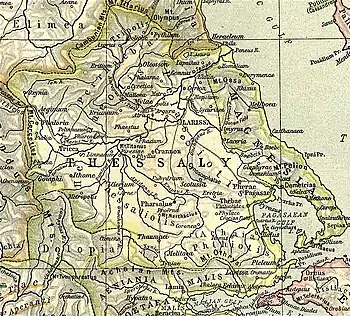38°51′10″N 22°25′50″E / 38.852784°N 22.430528°E

Antikyra or Anticyra (Ancient Greek: Αντίκυρα, romanized: Antíkyra[1] or Ἀντίκιρρα[2] - Antíkirra or Ἀντίκυρρα[3] - Antíkyrra or Ἀντίκυραι[4] - Antíkyrae) was an ancient Greek city and polis (city-state) on the right bank of the Spercheios near its mouth on the Malian Gulf in district of Malis in Thessaly.[5][6][7] To its south lay Mount Oeta. To distinguish it from the city of the same name in Phocis (now Boeotia), the Thessalian Antikyra was often distinguished as Malian Antikyra. Both were famed for their black and white hellebore, a prized herb in ancient Greek medicine.[8]
The editors of the Barrington Atlas of the Greek and Roman World tentatively identify the site of Anticyra at the modern village of Kostalexis (Κωσταλέξης) in the municipality of Lamia.[9]
See also
- Phocian Antikyra, also the modern Antikyra
- Locrian Antikyra, a phantom city invented by Titus Livius
Notes
- ↑ This form was used by Roman authors.
- ↑ Strabo. Geographica. Vol. pp. 418, 434. Page numbers refer to those of Isaac Casaubon's edition.
- ↑ Ptolemy. The Geography. Vol. 3.15.4.
- ↑ Stephanus of Byzantium. Ethnica. Vol. s.v.
- ↑ Mogens Herman Hansen & Thomas Heine Nielsen (2004). "Thessaly and Adjacent Regions". An inventory of archaic and classical poleis. New York: Oxford University Press. pp. 709–710. ISBN 0-19-814099-1.
- ↑ Chisholm 1911, p. 124.
- ↑
 Smith, William, ed. (1854–1857). "Anticyra". Dictionary of Greek and Roman Geography. London: John Murray.
Smith, William, ed. (1854–1857). "Anticyra". Dictionary of Greek and Roman Geography. London: John Murray. - ↑ Hahnemann 1812, p. 584.
- ↑ Richard Talbert, ed. (2000). Barrington Atlas of the Greek and Roman World. Princeton University Press. p. 55, and directory notes accompanying.
References
- Chisholm, Hugh, ed. (1911), , Encyclopædia Britannica, vol. 2 (11th ed.), Cambridge University Press, p. 124
- Hahnemann, Samuel (1812), Dissertatio Historico-Medica de Helleborismo Veterum ["Medical Historical Dissertation on the Helleborism of the Ancients"] (in Latin), Leipzig: reprinted 2004 in New Delhi as pp. 569–615 of Robert Ellis Dudgeon's Lesser Writings of Samuel Hahnemann, p. 584
Further reading
- , Encyclopædia Britannica, vol. 2 (9th ed.), 1878, p. 127